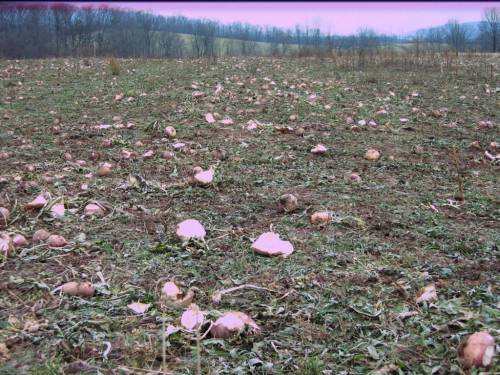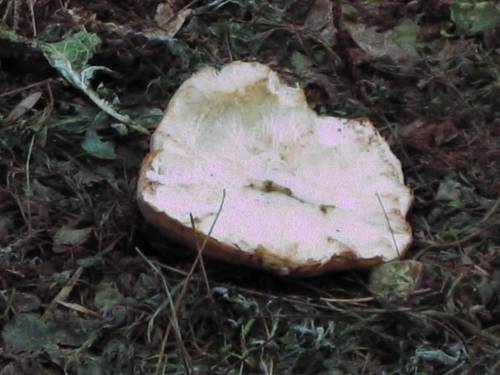 The pictures of the turnips are from last winter. Winter is always a tough time for pastures, especially for sheep. Many eastern beef grazers use tall fescue that becomes more palatable after the first heavy fall frosts, stays green late into the fall and early winter and stockpiles well. Sheep will eat it too, but not until everything else is gone. If you are managing pastures for the long-term, you don’t want everything else “gone”, or you will allow the fescue to outcompete all other forages, and end up with a fescue dominated pasture that has little multi-season value. So if you are a sheep grazer, you have a rare opportunity to kill 6 “birds”, yes SIX, with one stone. The first “bird” is the tall fescue. We purchased a farm that had a history of beef grazing and grass hay production. Part of both the pasture mix and hay mix probably had at least a component of tall fescue (maybe even endophyte-free tall fescue, but that is another story). So when we removed the cattle and added sheep grazing to the equation, the pasture and hay rapidly moved to tall fescue domination. Other factors that affected this transition were soil type, pH, fertility, rainfall patterns/drought, mowing/grazing timing and return intervals. Depending on how each of these factors are controlled for or occur on you farm, this transition time may vary considerably.
The pictures of the turnips are from last winter. Winter is always a tough time for pastures, especially for sheep. Many eastern beef grazers use tall fescue that becomes more palatable after the first heavy fall frosts, stays green late into the fall and early winter and stockpiles well. Sheep will eat it too, but not until everything else is gone. If you are managing pastures for the long-term, you don’t want everything else “gone”, or you will allow the fescue to outcompete all other forages, and end up with a fescue dominated pasture that has little multi-season value. So if you are a sheep grazer, you have a rare opportunity to kill 6 “birds”, yes SIX, with one stone. The first “bird” is the tall fescue. We purchased a farm that had a history of beef grazing and grass hay production. Part of both the pasture mix and hay mix probably had at least a component of tall fescue (maybe even endophyte-free tall fescue, but that is another story). So when we removed the cattle and added sheep grazing to the equation, the pasture and hay rapidly moved to tall fescue domination. Other factors that affected this transition were soil type, pH, fertility, rainfall patterns/drought, mowing/grazing timing and return intervals. Depending on how each of these factors are controlled for or occur on you farm, this transition time may vary considerably.  So when tall fescue exceeds 65% of fall pasture composition (see picture of 1 meter sampling frame and flag marking beginning of 100 m line transect for pasture composition and forage quantity calculations for USDA-NRCS-CSP program), my goal is to “manage” the tall fescue. I say manage, because I’m not sure the tall fescue will ever be gone entirely because the seed bank seems to be very durable and hardy. So “bird” #1 is the tall fescue. There are several ways to kill the fescue. It could be plowed under, but we are careful to conserve our shallow shale soils, so we only use no-till farming practices. The most successful method I have found is to graze the pasture heavily in the late summer or early fall or mow it short. Now I need to establish something that is useful for grazing, so the area is most fully utilized. No-till in the preferred legume mix and an appropriate grass if needed. Usually my choice is a legume mix that includes a grazing alfalfa, ladino clover and red clover, and depending on the site and anticipated grazing use, I’ll add or alternate alcike clover, crimson clover (an annual clover) or birdsfoot trefoil. The grasses (mostly orchard grass early, then later tall fescue) volunteer. So occasionally, a prolonged spring drought will negate those efforts, and I’ll have a “vacant” field as summer arrives. Now what do I do for summer forage (this is “bird” #2). Well, I switch to either forage sorghum (Sudex/Sudan grass – Prussic acid can be a concern) or buckwheat and turnips. Buckwheat can grow in very dry conditions, fixes nitrogen in the soil, and is very palatable to sheep. It also has the added benefits of a high water content, self-seeds in the same season, and is attractive to pollinating insects.
So when tall fescue exceeds 65% of fall pasture composition (see picture of 1 meter sampling frame and flag marking beginning of 100 m line transect for pasture composition and forage quantity calculations for USDA-NRCS-CSP program), my goal is to “manage” the tall fescue. I say manage, because I’m not sure the tall fescue will ever be gone entirely because the seed bank seems to be very durable and hardy. So “bird” #1 is the tall fescue. There are several ways to kill the fescue. It could be plowed under, but we are careful to conserve our shallow shale soils, so we only use no-till farming practices. The most successful method I have found is to graze the pasture heavily in the late summer or early fall or mow it short. Now I need to establish something that is useful for grazing, so the area is most fully utilized. No-till in the preferred legume mix and an appropriate grass if needed. Usually my choice is a legume mix that includes a grazing alfalfa, ladino clover and red clover, and depending on the site and anticipated grazing use, I’ll add or alternate alcike clover, crimson clover (an annual clover) or birdsfoot trefoil. The grasses (mostly orchard grass early, then later tall fescue) volunteer. So occasionally, a prolonged spring drought will negate those efforts, and I’ll have a “vacant” field as summer arrives. Now what do I do for summer forage (this is “bird” #2). Well, I switch to either forage sorghum (Sudex/Sudan grass – Prussic acid can be a concern) or buckwheat and turnips. Buckwheat can grow in very dry conditions, fixes nitrogen in the soil, and is very palatable to sheep. It also has the added benefits of a high water content, self-seeds in the same season, and is attractive to pollinating insects.  I no-till seed it with purple-top turnips in the early to mid summer. The buckwheat grows more quickly than the turnips, and I graze it (and also graze seperate annual forage sorghum and perennial native grass pastures with switchgrass, big bluestem, Indiangrass, side-oats grama, little bluestem and wildryes) in August when the cool-season grasses senesce. The buckwheat regrows, it gets grazed again, then the turnips take over. I think turnips could grow with no water and on rocks, they are TOUGH! When the rains finally come, the tops grow and the roots swell (we eat, sell, give away and enter these in the county fair (we win first prize every year, because we have acres of turnips to choose from [“bird” #3 – a human food in the pasture]). And we still don’t make a dent in the turnips. If it rains all summer, like this past summer, of course none of this is necessary. Now the fun part, the turnips continue to grow all fall, and provide a compatible nurse crop (“bird” #4) for the clover, which is now providing excess Nitrogen (“bird” #5) for the turnips. Fall provides sufficient pasture for the sheep until about late November, when the ground freezes, snow comes and we are out of non-fescue pasture. At this time, we turn the sheep into the turnips (“bird” #6).
I no-till seed it with purple-top turnips in the early to mid summer. The buckwheat grows more quickly than the turnips, and I graze it (and also graze seperate annual forage sorghum and perennial native grass pastures with switchgrass, big bluestem, Indiangrass, side-oats grama, little bluestem and wildryes) in August when the cool-season grasses senesce. The buckwheat regrows, it gets grazed again, then the turnips take over. I think turnips could grow with no water and on rocks, they are TOUGH! When the rains finally come, the tops grow and the roots swell (we eat, sell, give away and enter these in the county fair (we win first prize every year, because we have acres of turnips to choose from [“bird” #3 – a human food in the pasture]). And we still don’t make a dent in the turnips. If it rains all summer, like this past summer, of course none of this is necessary. Now the fun part, the turnips continue to grow all fall, and provide a compatible nurse crop (“bird” #4) for the clover, which is now providing excess Nitrogen (“bird” #5) for the turnips. Fall provides sufficient pasture for the sheep until about late November, when the ground freezes, snow comes and we are out of non-fescue pasture. At this time, we turn the sheep into the turnips (“bird” #6).  First they eat mostly the tops, occasionally pulling out a turnip by accident, and eating the root. Then overnight, it seems they remember that the roots are available, and they start eating the turnips. They eat them right down into the ground, pull them out, and everything in between. It looks like a turnip warzone when they are done, but the turnips don’t overwinter, so the goal is maximum utilization. To get this, we temporary fence the sheep into sections at a time to keep them focused on the task. On a good year, we get about 20 sheep/acre/month for the month of December. By January, the fun is done, and we transition to hay.
First they eat mostly the tops, occasionally pulling out a turnip by accident, and eating the root. Then overnight, it seems they remember that the roots are available, and they start eating the turnips. They eat them right down into the ground, pull them out, and everything in between. It looks like a turnip warzone when they are done, but the turnips don’t overwinter, so the goal is maximum utilization. To get this, we temporary fence the sheep into sections at a time to keep them focused on the task. On a good year, we get about 20 sheep/acre/month for the month of December. By January, the fun is done, and we transition to hay.
Sorry about the poor quality photos. Our camera was on its way out. Our sheep are not pink!
